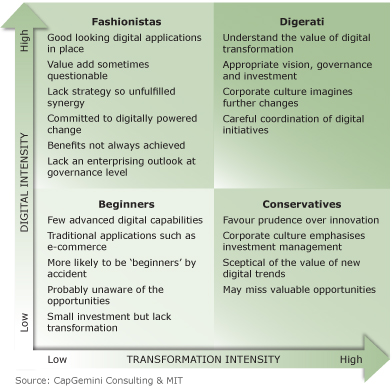Top down or bottom up?
What's the best way for an organisation to prosper from the opportunities that tools like social media offer? Social media is just one of the "web 2.0" technologies that were set to cause what some industry analysts called digital disruption.
Should it be top-down leadership that drives the transformation? Or should it be bottom-up innovation?
Research by MIT and CapGemini - The Digital Advantage: How digital leaders outperform their peers in every industry - aims to answer that question. The work is based on the experiences of about 400 organisations, including those in the public sector.
How to be successful
The good news is that the report says that the techniques adopted by successful organisations can be adopted by anyone.
MIT found that success is driven by top-down leadership and bottom-up innovation. The bottom-up creativity of staff can generate the ideas. But success needs a senior team that shares a common vision about changing the way the organisation operates. Those leaders need to be prepared to drive the change.
As I've posted previously, one issue is how many "digital savvy" CEOs are out there? And how many are not yet "digital" but have the foresight to recognise it and do something about it?
How mature is your organisation?
The MIT report looked at how "digitally mature" the organisations in the study were. It found that digital maturity is a combination of two separate - but related - characteristics:
- digital intensity – investing in the technology that changes how the organisation goes about its business; and
- transformation intensity – the leadership capabilities to drive digital transformation, such as vision, strategy, and governance.
MIT classed the organisations into four levels of digital maturity. Where would you place your organisation?

Need the less lovely but more readable HTML version?
Burberry joins the digerati
 One "digital" CEO is Angela Ahrendts at Burberry, the luxury goods retailer. At Burberry, she has given executive leadership a shake-up. Ahrendts created two linked groups, one as a hot-house for ideas, and the other to turn the best of those ideas into value-adding initiatives.
One "digital" CEO is Angela Ahrendts at Burberry, the luxury goods retailer. At Burberry, she has given executive leadership a shake-up. Ahrendts created two linked groups, one as a hot-house for ideas, and the other to turn the best of those ideas into value-adding initiatives.
- The Strategic Innovation Council is a monthly forum to gather the company's "young next generation of great thinkers." Ahrendts says that "… the remit of this council is to dream."
- The Senior Executive Council, chaired by Ahrendts, aims "to execute this young vision."
Ahrendts believes that forming these groups sends a loud and clear message: "We actually flipped the traditional hierarchy, and the way we communicated. These councils showed the entire company that we were serious about being creatively led." So this means that board thinking is now directly influenced by the ideas of the youngest in the company. It seems to be working, too.
